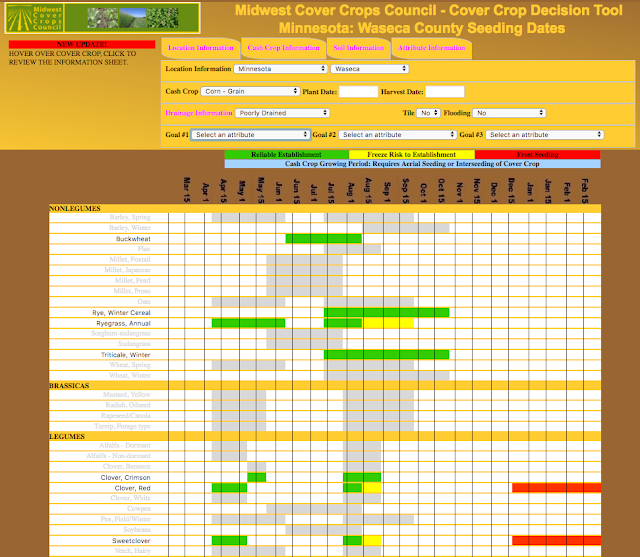July 27, 2018

Source: University of Minnesota Extension
By Lizabeth Stahl and M. Scott Wells
A quick review of climate and weather data from the Minnesota DNR reveals southern Minnesota has received 4 to 7 inches of precipitation above normal since April 1, 2018, with Southwestern MN receiving 4 inches of rain above normal over the past month. Excessive precipitation has led to ponding and flooding in fields, leaving drowned out spots and unplanted areas as the water recedes.

Cover crop planting options to reduce fallow syndrome in drowned fields.
Options for dealing with drowned-out/unplanted areas in fields at this point in the growing season
Do nothing:
If at all possible, this is an option to avoid. Left unattended, drowned-out areas can be overrun with weeds, leading to tremendous increases in the weed seedbank. This can impact weed control for years to come. Alternatively, if weeds do not take over and there is little plant growth in the area, fallow syndrome could impact crop yields the following year. Fallow syndrome can occur when there is not enough living root material for beneficial soil mycorrhizal fungi to survive. These “good” fungi facilitate uptake of phosphorus and other nutrients with limited mobility in the soil such as zinc. See “Reduce the risk of fallow syndrome with cover crops” for more details.
Mow areas:
Mowing weeds before they produce seed can help prevent contributions to the weed seedbank, but equipment limitations, accessibility, and the ability to mow areas before viable weed seeds are produced are challenges with this option.
Use tillage:
If you can get tillage equipment into affected areas throughout the season in a timely manner, tillage can help prevent weeds from getting out of control. Leaving these areas void of living plant material, however, does not address concerns about fallow syndrome (see above) or wind or water erosion impacts.
Plant a cover crop:
Planting a cover crop in drowned-out or unplanted spots can help reduce weed populations, prevent fallow syndrome, and reduce erosion potential. Species selection, seeding method, termination, herbicide interactions, and cost are considerations when determining which cover crop is the best fit.
Cover Crop Options
Where soybeans were originally planted, soybeans can be planted as a cover crop. This may be the one of the better options if low-cost seed is available, although do not expect any harvestable grain from soybeans planted after mid to late July. Planting soybeans where corn was originally planted is best avoided to prevent having three consecutive years of soybeans if the field is typically planted in a corn-soybean rotation. Soybean-on-soybean areas can lead to hot spots for soybean diseases.
When considering other cover crop options, it is a good idea to avoid cover crops that are poor hosts of soil mycorrhizae to reduce the potential for fallow syndrome. This includes, but is not limited to, the brassicas (e.g. mustards, radish, rape, and forage turnip). According to the Midwest Cover Crop Council Decision Tool, cereal rye and medium red clover (both winter hardy), annual ryegrass, buckwheat, crimson clover and sweetclover are good options when planting in late July/early August.
Taking into consideration seed cost, annual ryegrass may be one of the best fits for cover crops that winter terminate. If a cover crop that over-winters is desired, cereal rye is an ideal option. Both are relatively easy to use and respond well to broadcast incorporation and aerial seeding (assuming rainfall). When broadcast seeding, a rate of 77 to 140 lbs/acre of pure live seed for cereal rye and 21 to 70 lbs/acre of pure live seed for annual ryegrass is recommended. Check with your local seed supplier for prices and application cost.

Precipitation deviation from the norm for three southern Minnesota regions.
Further information on suggested planting dates, seeding rates and attributes of common cover crops can be found at https://z.umn.edu/ccoptions. The cover crop selection tool at www.mccc.msu.edu is another useful source of seeding information.
Previous herbicide applications may hinder cover crop establishment and prohibit the grazing of a cover crop. Even when rainfall has been high, concentration of a previously applied herbicide can be high enough in the soil to impact cover crop germination and growth since microbial activity is the primary driver in degradation of most products. As a general guideline, grass cover crops are at greater risk of injury where grass herbicides were applied, and broadleaf cover crops are at greater risk where broadleaf herbicides were applied. Higher cover crop seeding rates may help offset potential stand reductions, although there are no guarantees. Note that cereal rye has been one of the most tolerant cover crops species to a range of previously-applied herbicides in University trials. Consult the herbicide label of products used for guidance. Further information about herbicide interactions with cover crops can be found at https://z.umn.edu/ccandherbicides.
You May Also Like




